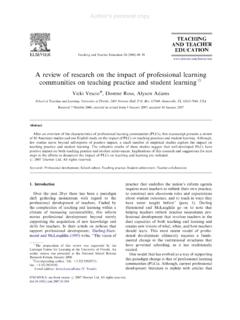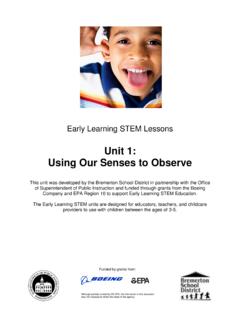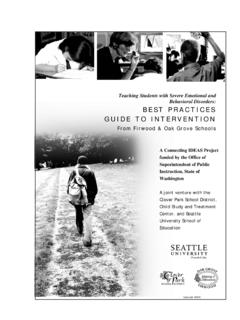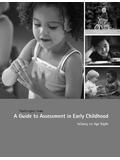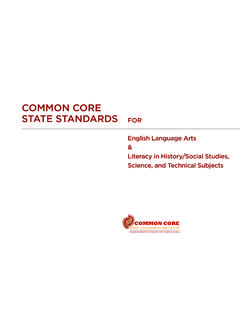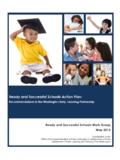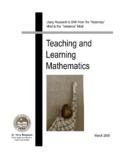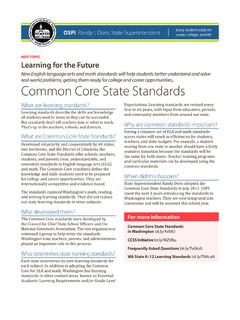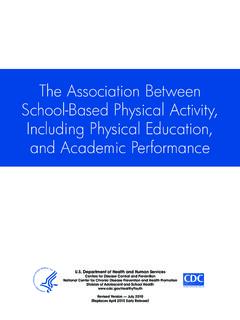Transcription of Health and Physical Education Standards - k12.wa.us
1 WJlhinaton STATE LEARNING S~NDARDS k i n d e r g a r t e n 1 2 t h g r a de Health & Physical Education Adopted in 2016 INTENTIONALLY LEFT BLANK Health and Physical Education Standards Health and Physical EducationOffice of Superintendent of Public Instruction Marissa Rathbone, Program SupervisorHealth and Physical Education Kathe Taylor, Assistant SuperintendentTeaching and Learning Randy I. Dorn Superintendent of Public Instruction Ken Kanikeberg Chief of Staff Gil Mendoza Assistant Superintendent March 2016 INTENTIONALLY LEFT BLANK SUPERINTENDENT OF PUBLIC INSTRUCTION Randy I. Dorn Old Capitol Building PO BOX 47200 Olympia, WA 96504-7200 Health and Physical Education K-12 Learning Standards Adoption Statement The 2016 Health and Physical Education K-12 Learning Standards were developed collaboratively with teachers, administrators, subject matter experts, state and national associations, and stakeholders in Health and Physical Education .
2 Teams of Washington state Health and Physical Education teachers started working on drafts in September 2014 with the aim to develop the mostcomprehensive, relevant, medically-accurate, and inclusive set of Health and Physical Education learning Standards for our state. Since the first draft was made available i n February 2015, the Health and Physical Education K- 12 Learning Standards have been reviewed by thousands of Washington educators, administrators, professionals, parents, and students. As part of the development process, the Standards underwent multiple reviews from many stakeholders including two Bias and Sensitivity Reviews and an extensive public comment period, allowing those with a stake in Health and Physical Education an opportunity to inform the development and implementation of the Standards .
3 Pursuant to RCW and RCW and based on widespread support and recommendations from students, educators, the state's Curriculum Advisory and Review Committee, and statewide Health and Physical Education stakeholders, I hereby adopt the 2016 Health and Physical Education K-12 Learning Standards . In accordance with state processes, Washington schools will transition to these Standards in the 2017-2018 school year. Adopted on this 25th day of March, 2016. Randy State Superintendent of PublicInstruction INTENTIONALLY LEFT BLANK Washington State K 12 Learning Standards for Health and Physical Education Learning Standards are for all of us: principals, administrators, decision-makers, teachers, and families.
4 They help define what is important for students to know and be able to do as they progress through school. Standards help ensure that students acquire the skills and knowledge they need to achieve personal and academic success. Standards also provide an avenue for promoting consistency in what is taught to students across our state from district to district, school to school, classroom to classroom. Health Education and Physical Education Are Essential Academic Subjects The mission of the Office of Superintendent of Public Instruction (OSPI) is to prepare students for college, career, and life. Health and Physical Education comprise extensive content areas that include, but are not limited to, the development of knowledge and skills to be physically active, eat nutritiously, access reliable Health information and services, communicate effectively, and set Health -enhancing goals.
5 These skills are learned in comprehensive Health and Physical Education learning environments that span from kindergarten through grade 12. Health Education and Physical Education support students academic performance in other subject areas, play a major role in reducing the cost of Health care statewide, and provide students with a global perspective on wellness. The state of Washington is committed to implementing high-quality Health and Physical Education instruction in order to: Lay the foundation knowledge for students to be healthy and well throughout life. Support the development of healthy and productive members of society. Prioritize the needs of each student by using inclusive language.
6 Emphasize instructional understanding and application of the Whole Child s Whole School, Whole Community, Whole Child (WSCC) model responds to the call improve each child s cognitive, Physical , social, and emotional development through greater alignment, integration, and collaboration between Education and Health . The WSCC model focuses on an ecological approach directed at the whole school, with the school in turn drawing its resources and influences from the whole community and serving to address the needs ofthe whole child. ASCD and the Centers for Disease Control and Prevention encourage use of the model as a framework for improving student learning and student Health in our nation s schools.
7 In the WSCC model, Health and Physical Education are seen as two distinctive academic disciplines that complement one another. Each attends to the development of short-termand long-term skills and competencies for academic and personal growth. For this reason,in 1 of 118 Washington state, Health Education and Physical Education each count on their own set of Standards and outcomes. By unravelling the links between the two disciplines and treating each independently, the Washington State K 12 Learning Standards will increase teacher understanding and expectations for preparation and delivery of instruction that is, where and when grade-level outcomes should be taught.
8 Washington State Learning Goals, Standards , and Outcomes These four learning goals are the foundation of all academic learning Standards in Washington state: Read with comprehension, write effectively, and communicate successfully in a varietyof ways and settings and with a variety of audiences; Know and apply the core concepts and principles of mathematics; social, Physical ,andlife sciences; civics and history, including different cultures and participation inrepresentative government; geography; arts; and Health and fitness [now namedphysical Education ]; Think analytically, logically, and creatively, and to integrate technology literacy andfluency as well as different experiences and knowledge to form reasoned judgments andsolve problems; and Understand the importance of work and finance and how performance, effort, anddecisions directly affect future career and educational Washington state learning Standards are the required elements of instruction and are worded broadly enough to allow for local decision-making.
9 Outcomes provide the specificityto support school districts in meeting each standard in each grade level. Depending on school resources and community norms, instructional activities may vary. The 2016 Health Education K 12 Learning Standards and Physical Education K 12 Learning Standards reflect OSPI s continuous commitment to supporting rigorous, inclusive, age-appropriate, and medically accurate instruction to ensure that students are prepared to live healthy, productive, and successful lives in a global society. The 2016 Health and Physical Education Standards and outcomes provide the guidance to teach, reinforce, and apply all of the state s learning goals.
10 They are aligned vertically to strengthen application of learning and depth of knowledge (see Appendix A). If implemented effectively, these Standards and outcomes will lead students to understand and apply the knowledge and skills necessary for safe and healthy living, and, in turn, for successful learning across all academic disciplines. 2 of 118 Health Education K 12 Learning Standards The National Health Education Standards (NHES) were developed to establish, promote, and support Health -enhancing behaviors for students in all grade levels from prekindergarten through grade 12. The NHES provide a framework for teachers, administrators, and policymakers to design or select curricula, allocate instructional resources, and assess student achievement and progress.

